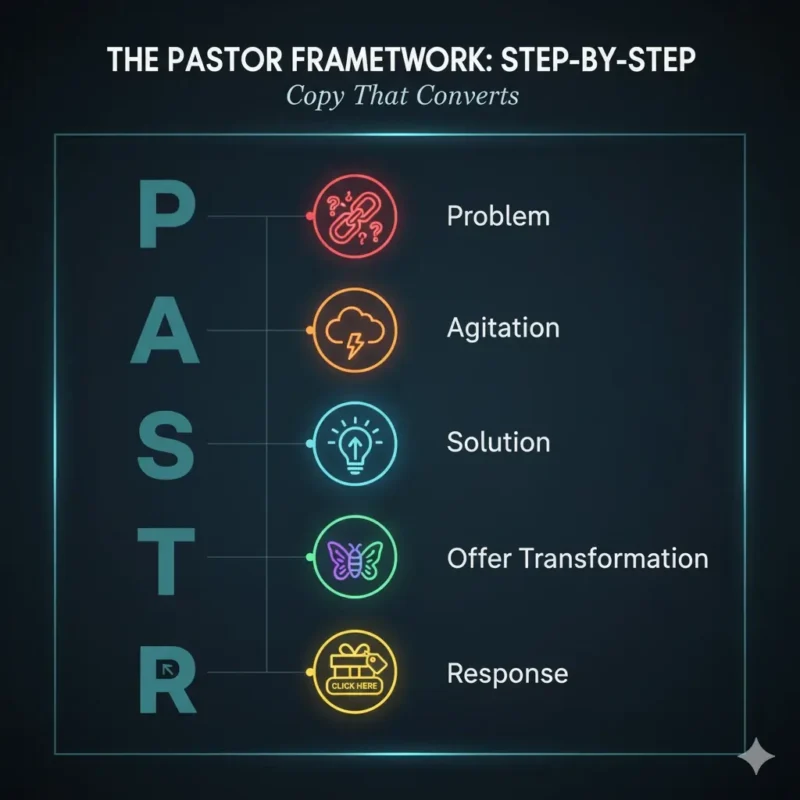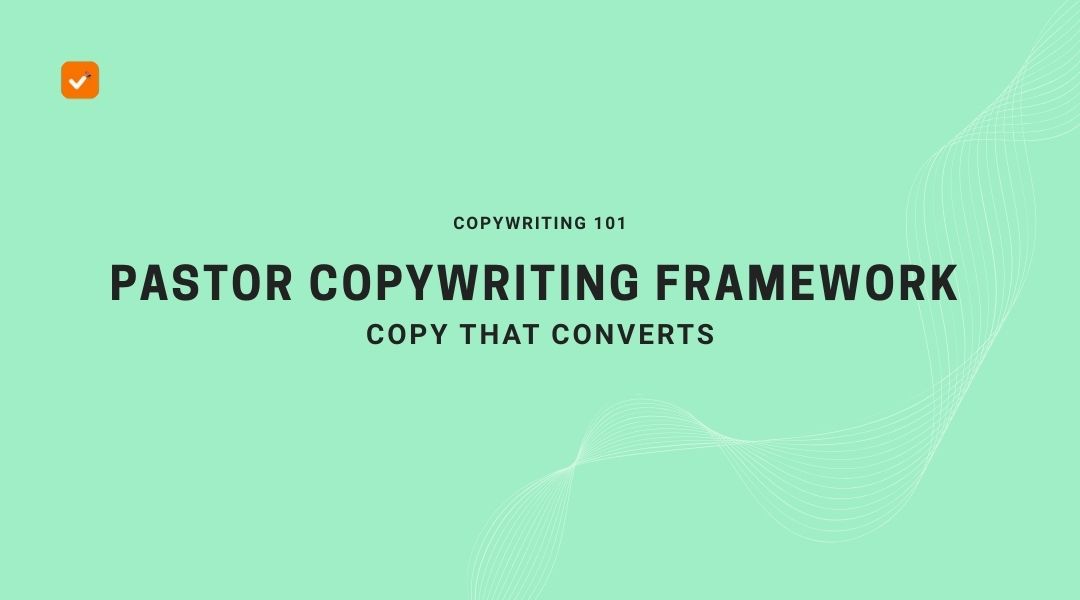Writing copy that actually converts can feel like rocket science.
You stare at a blank page.
You write a headline. Delete it. Write another one.
And you wonder: “Is there a system for this?“
The good news?
There is. And it’s called the PASTOR Copywriting Framework.
I’ve used the core principles of this framework to grow my own business, and I’ve seen it work for thousands of others. It’s a game-changer.
So in this guide, I’m going to break down the PASTOR framework step-by-step and tell you why it works so well in real-world marketing.
You’ll see exactly how to use it for your sales pages, emails, and even video scripts.
Let’s dive in.
What is the PASTOR Framework?
PASTOR is an acronym:

- P – Problem / Person / Pain
- A – Amplify / Aspiration
- S – Story / Solution
- T – Transformation / Testimony
- O – Offer
- R – Response
Instead of focusing on manipulation or hype, PASTOR focuses on guiding your reader like a trusted advisor. You walk them through their struggles, show you understand them, and then reveal how your solution can genuinely transform their lives.
Step 1 – P is for: Problem
No one cares about your product.
They only care about their problems.
That’s why the PASTOR framework starts here. If you can’t nail the problem, the rest of your copy is useless.
Your goal is to make your reader think:
“Wow, this person gets me.”
How do you do that?
By describing their problem even better than they can.
For example:
- Weak: “Our software helps with project management.”
- Strong: “Tired of juggling 5 different spreadsheets, a dozen email threads, and sticky notes just to keep a project on track?”
See the difference? The second one paints a vivid picture of a real problem.
ACTION STEP: Before you write a single word of copy, answer this: What is the #1 pain point my ideal customer is struggling with right now? Write it down in their own words.
Step 2 – A is for: Agitate
Okay, you’ve identified the problem. That’s the first and crucial step for PASTOR copywriting framework.
Now it’s time to pour a little salt in the wound.
This is where you agitate the problem. You dig into the frustration, the stress, and the consequences of not taking action.
Why does this matter?
Because people are far more motivated by avoiding pain than by gaining pleasure.
You need to show them the real cost of inaction.
Look:
- Problem: “Tired of juggling spreadsheets and emails?”
- Agitation: “Every missed deadline costs you credibility. Every hour spent searching for a file is an hour you can’t get back. How many more clients or opportunities will slip through the cracks before something changes?
You’re not just stating facts. You’re connecting the problem to real, emotional consequences.
PRO TIP: Use data to agitate. For example, instead of saying “wasting time,” say “losing up to 10 hours a week on administrative busywork.” Specific numbers make the pain feel more tangible.
Also read: 10 Best Startup Books for Every New Entrepreneur
Step 3 – S is for: Solution
Your reader is now feeling the pain of their problem.
They’re primed for a solution.
And that’s when you introduce your product or service as the answer.
But there’s a catch:
Don’t list features. Present your solution as the HERO.
Show them exactly how it solves the problem you just agitated.
For example:
- Weak: “Our product has Kanban boards, task assignments, and calendar integration.” (Features)
- Strong: “That’s exactly why we built ProjectFlow. It’s a single source of truth that replaces all those spreadsheets and email threads, giving you a crystal-clear view of every project… so you never miss a deadline again.” (Solution)
The solution is a direct response to the pain.
Step 4 – T is for: Transformation (and Testimonials)
This is the secret sauce.
People don’t buy project management software.
They buy an organized, stress-free life where they look like a rockstar at work.
In short: they buy the transformation.
Your job is to paint a vivid “after” picture for them. Show them what life looks like once their problem is solved.
And the best way to do that?
Testimonials.
Social proof is HUGE. When a potential customer sees someone just like them who achieved the transformation they want, the sale is halfway made.
Check out this example:
Before ProjectFlow, my team was in chaos. Now, we’re shipping projects 25% faster and my stress levels have plummeted. It’s been a complete game-changer. – Jane Doe, Marketing Manager at Acme Inc.
This testimonial doesn’t just say the product is good.
It shows a clear, desirable transformation.
Step 5 – O is for: Offer
Now it’s time to get specific.
What exactly are they getting?
Your Offer is more than just the price. It’s the entire package you present to the customer.
A strong offer typically includes:
The Core Product/Service: What they get.
- The Price: Be clear and upfront.
- Bonuses: What extra value are you adding? (Templates, guides, checklists).
- A Guarantee: How are you removing the risk? (e.g., “30-Day Money-Back Guarantee”).
- Urgency/Scarcity: Why should they act NOW? (e.g., “Bonus expires Friday,” “Only 10 spots left”).
Don’t be shy here. Spell out the value of every single component of your offer.
Step 6 – R is for: Response
You’ve done the hard work to reach the last step to master PASTOR framework.
You’ve highlighted the problem, agitated the pain, presented the solution, and made an irresistible offer.
Now, you have to do one last thing:
Tell them EXACTLY what to do next.
This is your Call to Action (CTA). And it needs to be brain-dead simple.
Don’t be vague.
- Weak: “Get in touch.”
- Strong: “Click the Orange Button Below to Get Instant Access.”
- Weak: “Learn more.”
- Strong: “Enter Your Email to Download The Free Guide.”
Make your CTA a big, bold button with clear, action-oriented text.
And remove any and all friction. The fewer steps they have to take, the higher your conversion rate will be.
Why PASTOR Works (Backed by Psychology)
The PASTOR framework is powerful because it taps into 3 proven persuasion principles:
- Empathy → You show you understand their pain.
- Storytelling → Humans are wired to respond to stories, not bullet points.
- Transformation → You don’t just sell a product, you sell a better version of them.
It’s not hype. It’s not manipulation. It’s authentic persuasion.
Final Thoughts
The next time you sit down to write sales copy, don’t stare at a blank page.
Pull out the PASTOR framework.
Walk your reader through their problem, amplify the stakes, tell a story, paint a transformation, present your offer, and guide them to respond.
Do this right, and you won’t just write “copy.”
You’ll write copy that converts.


Leave a Reply